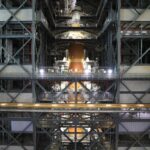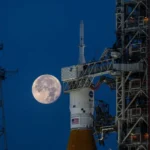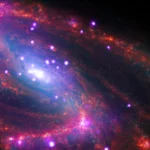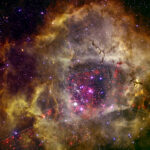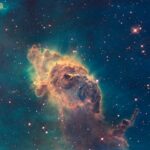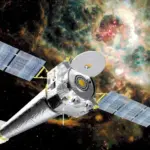Hot stars burn brightly in this new image from NASA’s Galaxy Evolution Explorer, showing the ultraviolet side of a familiar face. At approximately 2.5 million light-years away, the Andromeda Galaxy, or M31, is our Milky Way’s largest galactic neighbour. The entire galaxy spans 260,000 light-years across.
Hot stars burn brightly in this new image from NASA’s Galaxy Evolution Explorer, showing the ultraviolet side of a familiar face.
At approximately 2.5 million light-years away, the Andromeda Galaxy, or M31, is our Milky Way’s largest galactic neighbour. The entire galaxy spans 260,000 light-years across – a distance so large, it took 11 different image segments stitched together to produce this view of the galaxy next door.
The bands of blue-white making up the galaxy’s striking rings are neighbourhoods that harbour hot, young, massive stars. Dark blue-grey lanes of cooler dust show up starkly against these bright rings, tracing the regions where star formation is currently taking place in dense, cloudy cocoons. Eventually, these dusty lanes will be blown away by strong stellar winds, as the forming stars ignite nuclear fusion in their cores. Meanwhile, the central orange-white ball reveals a congregation of cooler, old stars that formed long ago.
When observed in visible light, Andromeda’s rings look more like spiral arms. The ultraviolet view shows that these arms more closely resemble the ring-like structure previously observed in infrared wavelengths with NASA’s Spitzer Space Telescope. Astronomers using Spitzer interpreted these rings as evidence that the galaxy was involved in a direct collision with its neighbour, M32, more than 200 million years ago.
Andromeda is so bright and close to us that it is one of only ten galaxies that can be spotted from Earth with the naked eye. This view is a two-colour composite, where blue represents far-ultraviolet light, and orange is near-ultraviolet light.
Image credit: NASA/JPL-Caltech
The Andromeda Galaxy, also known as Messier 31 or NGC 224, stands as the closest large galaxy to the Milky Way, located approximately 2.5 million light-years away in the constellation of Andromeda. This remarkable galaxy is one of the few that can be seen with the naked eye from Earth, making it a prominent feature in the night sky.
As a barred spiral galaxy, the Andromeda Galaxy showcases a stunning structure characterized by a central bar-shaped formation and spiral arms that extend outward. At its core lies a massive star cluster, accompanied by at least one supermassive black hole. Interestingly, Andromeda possesses a double nucleus; the brighter nucleus, known as P1, consists of an elliptical ring of ancient stars, while the dimmer nucleus, P2, harbour’s the supermassive black hole.
In terms of size, the Andromeda Galaxy boasts an impressive diameter of approximately 220,000 light-years and is home to around 1 trillion stars. Despite its larger star count, it is smaller in physical size compared to the Milky Way, primarily due to the Milky Way’s higher dark matter content.
Globular clusters add to the galaxy’s allure, with Andromeda hosting about 500 of these densely packed star clusters, which vary in age and composition. This number significantly surpasses the Milky Way, which contains around 160 globular clusters, highlighting Andromeda’s rich stellar environment.
The Andromeda Galaxy is not stationary; it is moving toward the Milky Way at a speed of approximately 100 to 140 kilometres per second. In about 4.5 billion years, a cosmic collision is anticipated, leading to the merging of the two galaxies into a giant elliptical galaxy. This event promises to reshape the structure of both galaxies and create a new stellar landscape.
The formation of the Andromeda Galaxy is believed to have occurred through the merger of smaller protogalaxies around 10 billion years ago. This merger initiated a high rate of star formation, which has gradually declined over the past 2 billion years. The galaxy’s halo, which extends about a million light-years from its core, is estimated to contain half the mass of its stars, contributing to its gravitational influence.
Throughout history, the Andromeda Galaxy has captured human imagination. Known since antiquity, it was initially classified as a nebula. In 1783, astronomer William Herschel estimated its distance to be around 18,000 light-years, a figure that would later be corrected as more advanced observational techniques emerged. His sister, Caroline Herschel, made her mark in history by independently discovering one of Andromeda’s satellite galaxies, M110.
Future observations promise to deepen understanding of the Andromeda Galaxy. The James Webb Space Telescope and other cutting-edge instruments are set to provide detailed insights into its evolutionary history, stellar formation processes, and the dynamics of its various components. These advancements in observational technology will unveil the mysteries surrounding this captivating galaxy and its role in the broader cosmic tapestry.
In summary, the Andromeda Galaxy stands as a fascinating subject of study in the field of astronomy. Its proximity, structure, and impending collision with the Milky Way make it a unique and important object of interest. As research continues and technology advances, the Andromeda Galaxy will undoubtedly reveal even more of its secrets, enriching our understanding of the universe and our place within it.
With its rich history and future potential for discovery, the Andromeda Galaxy remains a key player in the cosmic drama unfolding across the universe. Whether viewed through a telescope or studied through advanced instruments, it continues to inspire awe and curiosity, reminding humanity of the vastness and complexity of the cosmos.
As scientists and astronomers look to the future, the Andromeda Galaxy will undoubtedly remain a focal point for exploration and understanding, bridging the gap between our own Milky Way and the mysteries of the universe beyond. The journey of discovery is far from over, and the Andromeda Galaxy is poised to take centre stage in the ongoing quest for knowledge about the cosmos.
In the grand scheme of the universe, the Andromeda Galaxy serves as a reminder of the interconnectedness of galaxies and the dynamic nature of cosmic evolution. Its story is one of formation, collision, and transformation, echoing the themes of change and continuity that define the universe itself. As researchers delve deeper into its secrets, the Andromeda Galaxy will continue to illuminate the path toward a greater understanding of the cosmos and humanity’s place within it.



